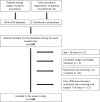A positive association between nutritional risk and the incidence of surgical site infections: A hospital-based register study
- PMID: 29763425
- PMCID: PMC5953435
- DOI: 10.1371/journal.pone.0197344
A positive association between nutritional risk and the incidence of surgical site infections: A hospital-based register study
Abstract
Surgical site infections (SSI) are amongst the most common health care-associated infections and have adverse effects for patient health and for hospital resources. Although surgery guidelines recognize poor nutritional status to be a risk factor for SSI, they do not tell how to identify this condition. The screening tool Nutritional Risk Screening 2002 is commonly used at hospitals to identify patients at nutritional risk. We investigated the association between nutritional risk and the incidence of SSI among 1194 surgical patients at Haukeland University Hospital (Bergen, Norway). This current study combines data from two mandatory hospital-based registers: a) the incidence of SSI within 30 days after surgery, and b) the point-prevalence of patients at nutritional risk. Patients with more than 30 days between surgery and nutritional risk screening were excluded. Associations were assessed using logistic regression, and the adjusted odds ratio included age (continuous), gender (male/female), type of surgery (acute/elective) and score from The American Society of Anesthesiologists Physical Status Classification System. There was a significant higher incidence of SSI among patients at nutritional risk (11.8%), as compared to those who were not (7.0%) (p = 0.047). Moreover, the incidence of SSI was positively associated with the prevalence of nutritional risk in both simple (OR 1.76 (95% CI: 1.04, 2.98)) and adjusted (OR 1.81 (95% CI: 1.04, 3.16)) models. Answering "yes" to the screening questions regarding reduced dietary intake and weight loss was significantly associated with the incidence of SSI (respectively OR 2.66 (95% CI: 1.59, 4.45) and OR 2.15 (95% CI: 1.23, 3.76)). In conclusion, we demonstrate SSI to occur more often among patients at nutritional risk as compared to those who are not at nutritional risk. Future studies should investigate interventions to prevent both SSI and nutritional risk among surgical patients.
Conflict of interest statement
References
-
- Point prevalence survey of healthcare-associated infections and antimicrobial use in European acute care hospitals 2011–2012 European Centre for Disease Prevention and Control; 2013 [cited 2017]. Available from: http://ecdc.europa.eu/en/publications/Publications/healthcare-associated....
-
- Magill SS, Edwards JR, Bamberg W, Beldavs ZG, Dumyati G, Kainer MA, et al. Multistate point-prevalence survey of health care-associated infections. The New England journal of medicine. 2014;370(13):1198–208. doi: 10.1056/NEJMoa1306801 - DOI - PMC - PubMed
-
- Whitehouse JD, Friedman ND, Kirkland KB, Richardson WJ, Sexton DJ. The impact of surgical-site infections following orthopedic surgery at a community hospital and a university hospital: adverse quality of life, excess length of stay, and extra cost. Infection control and hospital epidemiology. 2002;23(4):183–9. doi: 10.1086/502033 - DOI - PubMed
-
- Delgado-Rodriguez M, Gomez-Ortega A, Llorca J, Lecuona M, Dierssen T, Sillero-Arenas M, et al. Nosocomial infection, indices of intrinsic infection risk, and in-hospital mortality in general surgery. The Journal of hospital infection. 1999;41(3):203–11. - PubMed
-
- Badia JM, Casey AL, Petrosillo N, Hudson PM, Mitchell SA, Crosby C. Impact of surgical site infection on healthcare costs and patient outcomes: a systematic review in six European countries. The Journal of hospital infection. 2017;96(1):1–15. doi: 10.1016/j.jhin.2017.03.004 - DOI - PubMed
Publication types
MeSH terms
LinkOut - more resources
Full Text Sources
Other Literature Sources


